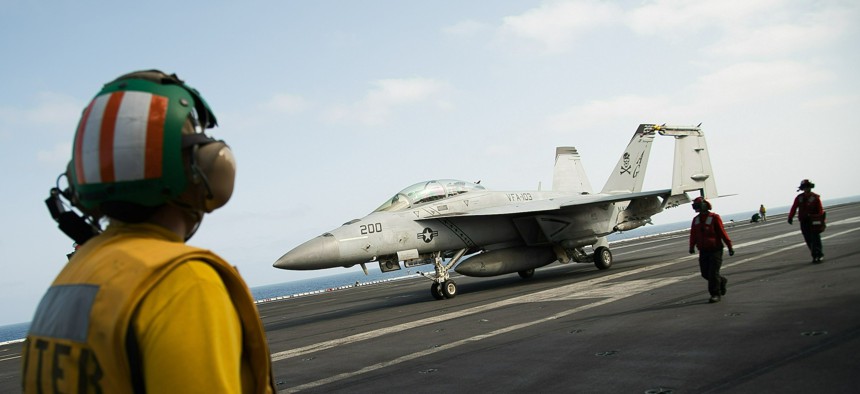
A crew member looks at a taxing F/A-18 fighter jet on the deck of the USS Abraham Lincoln aircraft carrier in the Arabian Sea, Monday, June 3, 2019. AP Photo/Jon Gambrel
How to Step Back from the Brink with Iran
Right now, everything both sides do to strengthen their defenses looks to the other side like preparation for attack.
As the Trump administration accuses Iran of attacking oil tankers in the Gulf of Oman, rising tensions create a real danger of stumbling into a catastrophic war neither side wants. The time has come to step away from the brink.
Iran and the United States are locked in a security dilemma: everything each side does to strengthen its defenses looks to the other side like preparation for attack. The mutual hostility and distrust between the two governments leads each to put the most threatening possible spin on everything the other does. Potential sparks that could ignite a conflagration are everywhere, with crowded ship traffic in the Persian Gulf; ongoing fighting in Yemen, Syria, and Afghanistan; tension between U.S.-backed and Iranian backed factions in Iraq; and Iranian-backed groups threatening Israel.
It is worth remembering that with the temperature this hot and so many pieces on the board, incidents happen that no national leader directed. In 1988, at another moment of tension, the USS Vincennes mistook a civilian Iranian airliner for an attacking warplane and shot it down, killing all 290 people aboard. In the Cuban Missile Crisis, no one ordered a U.S. spy plane to fly into Soviet airspace – but one did, by accident. Soviet leaders did not want their troops to shoot down U.S. spy planes over Cuba – but they shot one down anyway. President Kennedy and Defense Secretary Robert McNamara did not even know that the Navy, in enforcing the “quarantine” around Cuba, was dropping explosives on nuclear-armed Soviet submarines, nearly causing one of them to launch its nuclear weapons. If either side had lashed back after one of these incidents, much of modern civilization might no longer exist.
Leaders’ ability to control events in the Persian Gulf is even worse, as neither Iran nor the United States has full command over all the forces they back. U.S.-supported units from Saudi Arabia and the United Arab Emirates, Israeli forces, Iranian-backed militias, and armed groups like Hezbollah – with an arsenal of over 100,000 missiles and rockets pointed at Israel, many of them now precision-guided – each have their own hotheaded commanders and their own interests to defend.
Related: Iran Has Options and It’s Starting to Use Them
Related: Deterrence Is Failing — Partly Because Iran Has No Idea What the US Really Wants
Related: Trump’s ‘Maximum Pressure’ Won’t Make Iran Yield
Some leaders, including National Security Advisor John Bolton, have argued that military action against Iran is needed, to destroy Iran’s nuclear program and possibly overthrow its Islamic regime. Nothing could be more misguided. Iran’s territory and population are several times as big as Iraq’s, yet the Iraq war has dragged on for 16 years at a cost of thousands of U.S. lives, hundreds of thousands of Iraqi lives, and trillions of dollars, contributing to setting much of the Middle East on fire. In retaliation to a U.S. strike, Iranian-backed militias throughout the Middle East could attack U.S. forces and allies, Iran’s own missiles and Hezbollah’s missiles and rockets could impose terrible damage on Israel, and Iran could sponsor or encourage terrorist attacks around the world for years to come.
While U.S. strikes could set back Iran’s nuclear program for a few years, Iran could kick out international inspectors and rebuild at secret sites. The United States or Israel might find and strike those sites – but that could provoke further retaliation, potentially leading to a war that could drag on for years. Ultimately, a U.S. attack would probably increase, not decrease, the chance that Iran would choose to build nuclear weapons.
What should be done? First, President Trump should tell Iran clearly: if you do not attack or sponsor attacks on our forces or allies, and do not come close to a nuclear weapon capability, you have nothing to fear from the United States.
Second, President Trump should issue clear orders to U.S. forces not to strike at Iran or its forces without his direct orders. The situation is too dangerous to leave decisions to lower levels of command.
Third, President Trump should make clear to U.S. allies in the region that the United States will not stand behind them if they take actions that escalate to conflict without discussing and agreeing on those steps with the United States in advance.
Fourth, both sides should announce that they will behave as though there were an “incidents at sea” agreement between them, a pact that bars dangerous close approaches by ships and aircraft. Should such incidents occur, they should seek discussions, rather than rapidly striking back.
More broadly, both sides need to look for ways to move back from the brink — taking advantage, for example, of Japanese Prime Minister Shinzo Abe’s mediation efforts to work out “rules of the road” for their ongoing dispute. Once the temperature has cooled, they need to find a path to a renewed deal on nuclear restraint and lifting of sanctions. The problem with brinksmanship is that sometimes you slide over the brink.



